
Anemone is a genus of flowering plants in the buttercup family Ranunculaceae. Plants of the genus are commonly called windflowers. They are native to the temperate and subtropical regions of all continents except Australia, New Zealand and Antarctica. The genus is closely related to several other genera including Anemonoides, Anemonastrum, Hepatica, and Pulsatilla. Some botanists include these genera within Anemone.

The Edwards Plateau is a geographic region forming the crossroads of Central, South and West Texas, United States. It is bounded by the Balcones Fault to the south and east; the Llano Uplift and the Llano Estacado to the north; and the Pecos River and Chihuahuan Desert to the west. San Angelo, Austin, San Antonio and Del Rio roughly outline the area. The plateau, especially its southeast portion, is also known as the Texas Hill Country.
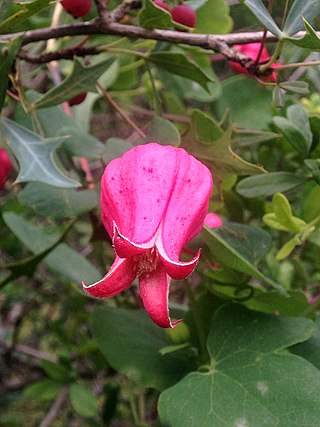
Clematis texensis, commonly called scarlet leather flower, is a climbing vine in the buttercup family (Ranunculaceae). It is native to the United States, where it is endemic to the Edwards Plateau of Texas. Its natural habitat is on rocky limestone cliffs and streamsides.

Thelesperma filifolium, commonly known as stiff greenthread, or plains greenthread, is a species of flowering plant in the aster family, Asteraceae. It is often found growing in shallow soils. It prefers disturbed sites in dry, sandy or gravelly soil with a neutral to basic pH. Stiff greenthread adapts to various soil conditions, including loam, clay, caliche, and roadsides. It blooms between March and June and often into the fall.
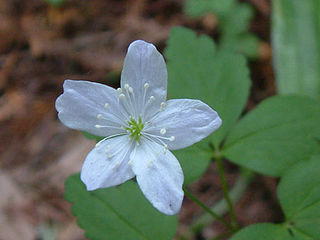
Anemonoides quinquefolia, a flowering plant in the buttercup family Ranunculaceae, is native to North America. It is commonly called wood anemone or windflower, not to be confused with Anemonoides nemorosa, a closely related European species also known by these common names. The specific epithet quinquefolia means "five-leaved", which is a misnomer since each leaf has just three leaflets. A plant typically has a single, small white flower with 5 sepals.

Thalictrum thalictroides, the rue-anemone, is a herbaceous perennial plant native to woodland in eastern North America. It has white or pink flowers surrounded by a whorl of leaflets, and it blooms in spring.

Anemone virginiana is an upright growing herbaceous species of flowering plant buttercup family Ranunculaceae. It is a perennial that grows 30–80 centimetres (12–31 in) tall, flowering from May until July, the flowers are white or greenish-white. After flowering the fruits are produced in a dense rounded thimble shaped spikes 15–35 millimetres (0.59–1.38 in) long and 12 millimetres (0.47 in) wide. When the fruits, called achenes, are ripe they have gray-white colored, densely woolly styles, that allow them to blow away in the wind. The leaf structure is whorled halfway up the stem and each individual leaf appears to be deeply cut. Native from eastern North America, where it is found growing in dry or open woods. This plant can be found in 38 out of the 50 states in the U.S. and is located anywhere from Maine to Minnesota going west, and found as far south as Georgia and Louisiana.
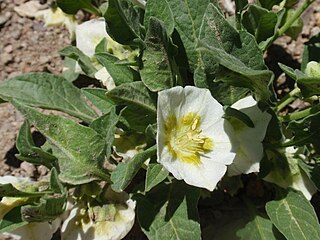
Chamaesaracha is a genus of perennial herbs in the nightshade family which are known commonly as five eyes. There are around nine species of five eyes, and they are native to the southwestern and western United States and parts of Mexico. These are hairy plants growing low to the ground and covered in crinkly dull green leaves. The flowers are star-shaped to wheel-shaped and their dried remnants can be found around the fruits, which are spherical berries filled with flat, kidney-shaped seeds.
Enemion stipitatum is a species of flowering plant in the buttercup family known by the common name Siskiyou false rue anemone. It is native to northern California and southern Oregon where it grows in forest, woodland, and chaparral habitats in the local mountain ranges. This is a petite perennial herb producing one or more erect, unbranched stems to a maximum height no more than 15 centimeters. Leaves appear toward the top of each stem in arrays of several cloverlike leaves with three-lobed leaflets. The tiny solitary flowers each have five white petallike sepals only a few millimeters long. The center of the flower contains several thick white stamens topped with small yellow anthers and 3 to 5 styles.

Salvia roemeriana is a herbaceous perennial shrub native to the Edwards Plateau in Texas, along with parts of Arizona, and several states in Mexico. The epithet honors German geologist Ferdinand von Roemer, who lived in Texas from 1845 to 1847 and became known as the "father of Texas geology". The common name refers to the cedar brakes where it commonly grows. It also grows in oak woodlands and rock outcroppings. It was introduced into horticulture in 1852, and was a favorite of renowned garden writer William Robinson for its neatness as an edging plant and in front of borders.

Salvia pentstemonoides is a herbaceous perennial that is rare in nature and native to only a few locations in Texas, including the Edwards Plateau. The plant remains endangered due to destruction of habitat and browsing by deer. The severe Texas drought of the 1950s may have contributed to its decline.

Balcones Canyonlands is a national wildlife refuge located in the Texas Hill Country to the northwest of Lago Vista, Texas. The refuge was formed in 1992 to conserve habitat for two endangered songbirds, the golden-cheeked warbler and the black-capped vireo, and to preserve Texas Hill Country habitat for numerous other wildlife species. The refuge augments a similarly named preserve in Austin called the Balcones Canyonlands Preserve.

Grass Wood is an ancient woodland of 88 hectares in Wharfedale, North Yorkshire, England, that has an exceptional ground flora of woodland wildflowers.

Salvia ballotiflora is a species of flowering plant in the mint family, Lamiaceae, that is native to Texas in the United States as well as northeastern and central Mexico. Common names include shrubby blue sage and mejorana.

Enemion biternatum, commonly known as the false rue-anemone, is a spring ephemeral native to moist deciduous woodland in the eastern United States and extreme southern Ontario.

Astranthium integrifolium, the entireleaf western daisy or eastern western-daisy, is a North American species of flowering plants in the family Asteraceae. It is native to the east-central part of the United States primarily the Cumberland Plateau and Ohio/Tennessee Valley. It is found in the States of Tennessee, Kentucky, Alabama, and Georgia, with isolated populations in Mississippi and West Virginia.

Gratiola quartermaniae, commonly known as the limestone hedge-hyssop, is a species of flowering plant in the plantain family. It is native to eastern North America.
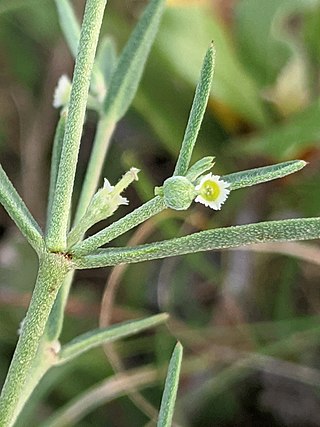
Euphorbia angusta is a species in the Euphorbiaceae (spurge) family with the common name blackfoot sandmat. It is native to central and south Texas and northern Mexico.
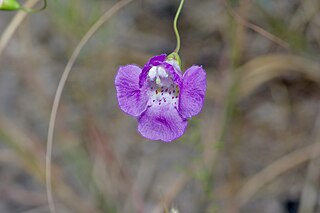
Agalinis edwardsiana is a flowering plant species in the family Orobanchaceae family with the common name plateau agalinis.
Phlox roemeriana, the goldeneye phlox, is a species of flowering plant in the family Polemoniaceae, native to Texas. There it is found only on dry limestone soils of the Edwards Plateau and nearby areas of the High Plains. An annual reaching 13 cm (5 in), it has pink flowers with a yellow center.


















